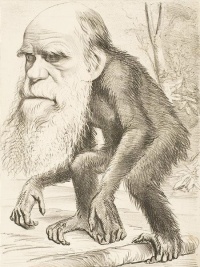Hominidae
From The Art and Popular Culture Encyclopedia
|
Related e |
|
Featured: |
The Hominidae, whose members are known as great apes or hominids, are a taxonomic family of primates that includes eight extant species in four genera: Pongo, the Bornean, Sumatran and Tapanuli orangutan; Gorilla, the eastern and western gorilla; Pan, the common chimpanzee and the bonobo; and Homo, of whom only modern humans remain, with several extinct relatives (e.g., the Neanderthal) and ancestors, such as Homo erectus.
Several revisions in classifying the great apes have caused the use of the term "hominid" to vary over time. Its original meaning referred only to humans (Homo) and their closest extinct relatives. That restrictive meaning has now been largely assumed by the term "hominin", which comprises all members of the human clade after the split from the chimpanzees (Pan). The current, 21st-century meaning of "hominid" includes all the great apes including humans. Usage still varies, however, and some scientists and laypersons still use "hominid" in the original restrictive sense; the scholarly literature generally shows the traditional usage until around the turn of the 21st century.
Within the taxon Hominidae, a number of extant and known extinct, that is, fossil, genera are grouped with the humans, chimpanzees, and gorillas in the subfamily Homininae; others with orangutans in the subfamily Ponginae (see classification graphic below). The most recent common ancestor of all Hominidae lived roughly 14 million years ago, when the ancestors of the orangutans speciated from the ancestral line of the other three genera. Those ancestors of the family Hominidae had already speciated from the family Hylobatidae (the gibbons), perhaps 15 million to 20 million years ago.
See also
- Bili ape
- Dawn of Humanity (2015 PBS film)
- Great ape language
- Great ape research ban
- Great Apes Survival Partnership
- Kinshasa Declaration on Great Apes
- List of human evolution fossils
- List of individual apes
- Oldest hominids
- Prehistoric Autopsy (2012 BBC documentary)
- Primate cognition
- The Mind of an Ape
- Timeline of human evolution



